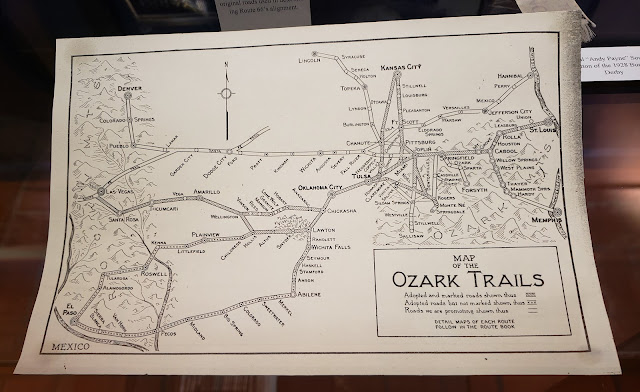We think Warwick, Luther, and Arcadia, Oklahoma, have some of the most interesting stops along Route 66 in Oklahoma. Our first stop along this stretch of Route 66 was the Seaba Station in Warwick, Oklahoma.
 |
| Seaba Station in Warwick, Oklahoma |
The distinctively-styled Seaba Station was built in 1921 or 1924 (sources give varying dates). This makes it one of the oldest gas stations on Route 66 offering full automobile service, not just gas.
Today the station houses the Seaba Station Motorcycle Museum and a gift shop. The museum is free but donations are appreciated. It’s an impressive collection.
Behind the Seaba Station are the preserved remains of its outhouse, also built in the 1920s.
 |
| Seaba Station outhouse |
The interior looks like it was surprisingly nice for its time.
 |
| Seaba Station outhouse interior |
From
Warwick, Oklahoma, we continued about 2 miles on OK 66. Just after crossing
I-44, we forked right (northwest) on an earlier “alignment” of Route 66: OK 66B
into Wellston, Oklahoma. OK 66B turns left (west) on 2nd Street,
then rejoins the newer alignment (OK 66).
About 2½ miles later, on the eastern outskirts of Luther, Oklahoma, we reached what we think is one of the most historically important stops on Route 66: the Threatt Filling Station (pronounced "Treat") on the southwest corner of OK 66 and Pottawatomi Road.
 |
| Threatt Filling Station in Luther, Oklahoma, in April 2022 |
If travel on early Route 66 was hard for so many people, it was especially hard for African Americans. Many places along Route 66 refused to serve them, and many towns along Route 66 were “sundown towns” where African Americans couldn’t stay past sundown.
Allen Threatt, Sr., an African American, owned a farm outside Luther. In 1915 he decided to build a gas station on the edge of his property that bordered what was then OK 7. Until the 1950s, the Threatt Station was one of the few places along Route 66 where African Americans were welcome. The Threatts added groceries and a café, allowed African American travelers to camp overnight on their farm, and hosted weekend dances and Negro baseball league games.
We were glad to see the Threatt Station under restoration when we visited. We’re looking forward to visiting it when it reopens.
 |
| Another view of the Threatt Station being rehabilitiated in April 2022 |
West of Luther are the remains of another old stone gas station.
 |
| Remains of an old gas station west of Luther, Oklahoma |
This
gas station is about half a mile west of North Choctaw Road, on the north side
of Route 66. I couldn't find out much about its history. Someone on Facebook shared this article that confirms how little is known about it.
About a mile past those ruins, OK 66 curves to the northwest. We forked left onto an early “alignment” of Route 66 built in 1928-1929. This segment was paved in two ways. As the photo below shows, the eastern half was paved in concrete in 1928.
 |
| Looking west from OK 66 at the eastern end of a 1928-29 segment of Route 66 east of Arcadia, Oklahoma |
(This is one of our favorite photos of our Route 66 road trips to date. For us, it captures the fun and excitement of our Route 66 road trip: a historic, off-the-beaten-path road with unknown experiences off in the distance.)
The western half of this segment was paved in 1929 using an experimental approach of macadam over concrete with curbs.
 |
| Western half of a 1928-1929 segment of Route 66 east of Arcadia, Oklahoma |
Along the western half of the road is a sign commemorating Paul McCartney driving Route 66 when he was…66 years old.
 |
| Sign commemorating Paul McCartney's Route 66 road trip east of Arcadia, Oklahoma |
Just before this old segment merges back into OK 66, look on the right for an old cottage-style Phillips 66 station that’s now part of a house.
 |
| Former Phillips 66 station converted into a private home east of Arcadia, Oklahoma (from Google Maps) |
We loved driving this old stretch of Route 66. It’s another one of those stretches where you feel you’re going back in time and getting a sense of what it was like to drive cross country 100 years ago.
About a mile after rejoining OK 66 is another Route 66 icon: the Round Barn at 107 OK 66 in Arcadia.
 |
| Round Barn in Arcadia, Oklahoma |
The Round Barn was built in 1898 under the theory that a round barn might be less susceptible to tornadoes. Today it houses a gift shop.
About
a quarter mile past the Round Barn is yet another famous stop on Route 66: Pops
66 Soda Ranch at 660 Route 66 in Arcadia, Oklahoma.
 |
| Pops 66 Soda Ranch in Arcadia, Oklahoma |
We stopped here for lunch, and we were glad to did! The classic diner food was great, the service friendly, and the interior bright and sparkling clean.
 |
| Interior of Pops 66 Soda Ranch in Arcadia, Oklahoma |
And of course there are 500 soda flavors to choose from! They’re helpfully grouped by flavor. (The ones by the windows are for display; the ones to choose from are in refrigerated cases.)
After Pops, we continued about 4 or 5 miles on OK 66 to I-35, where Route 66 becomes US 77. Then it was another 3 miles into Edmond, Oklahoma. US 77 turns left (south) in the middle of Edmond. It becomes I-235, which continues into Oklahoma City.















